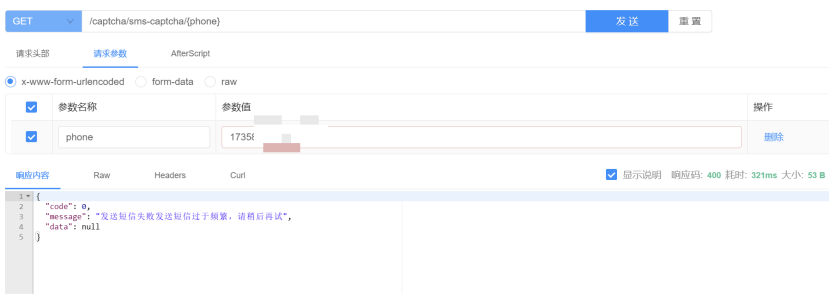- Spring容器结构
- 【论文笔记】Mamba:挑战Transformer地位的新架构
- Spring Boot集成百度UidGenerator雪花算法使用以及
- SpringCloudGateway之统一鉴权篇
- mysql如何自定义自增主键值,以及所遇到的不生效问题
- Mysql为什么只能支持2000w左右的数据量?
- 云计算——ACA学习 阿里云云计算服务概述
- K8S--安装metrics-server,解决error: Metr
- Python+Mysql实现登录注册
- 惊艳的KMP字符串匹配算法
- 【SQL相关】Hive行列字符串的合并与拆分
- 虚幻引擎架构自动化及蓝图编辑器高级开发进修班
- docker搭建部署mysql并挂载指定目录
- MySQL中的SQL高级语句[一](上篇)
- 【STM32项目】基于STM32多传感器融合的新型智能导盲杖设计(完整
- idea2023专业版安装破解+maven配置教程
- 解决SpringBoot日期序列化问题:[Java 8 datetim
- MSTP协议配置(华为ensp)
- 云计算的大数据处理:实时分析与批处理
- 如何利用SpringSecurity进行认证与授权
- 【MySQL】内外连接——内连接、外连接、左外连接、右外连接、内外连接
- IDEA启动Springboot报错:无效的目标发行版:17 的解决办
- vanna:基于RAG的text2sql框架
- Windows下搭建Tomcat HTTP服务,发布外网远程访问
- 【PHP系统学习】——Laravel框架数据库的连接以及数据库的增删改
- 基于在线学习的分布式流量实时分析系统设计与实现
- Spring Boot实现登录注册的三种基本方式
- Nginx模块之rewrite模块
- 前后端分离Springboot 整合使用activiti7教程(一)(
- 使用PySpider进行IP代理爬虫的技巧与实践

⛰️个人主页: 蒾酒
🔥系列专栏:《spring boot实战》
🌊山高路远,行路漫漫,终有归途
目录
写在前面
上文衔接
内容简介
1.依赖导入
2.接口分析
3.实现思路
3.功能实现
创建发送短信工具类
配置阿里云短信服务
接口代码实现
4.功能测试
写在最后
写在前面
本文介绍了springboot开发后端服务中,短信验证码接口功能的设计与实现,坚持看完相信对你有帮助。
同时欢迎订阅springboot系列专栏,持续分享spring boot的使用经验。
上文衔接
本文衔接上文,可以看一下:
spring boot3登录开发-2(1图形验证码接口实现)_用户登录验证码接口设计-CSDN博客文章浏览阅读5.2k次,点赞146次,收藏109次。上文我们已经整合好了jwt,本文我们开始实现图形验证码接口的实现。通过糊涂工具包的图形验证码工具完成获取验证码接口通过redis缓存key(验证码id)-value(验证码内容)_用户登录验证码接口设计https://blog.csdn.net/qq_62262918/article/details/136064820?spm=1001.2014.3001.5502
内容简介
上文我们已经整合好了jwt,本文我们开始实现短信验证码接口的实现。这里我选用阿里云的短信服务。本文侧重点在于设计思路,阿里云控制台开通短信服务,你跟着流程走一遍就可以。个人也是可以申请的。

短信验证码接口实现
1.依赖导入
导入阿里云短信服务SDK
pom.xml:
com.aliyun dysmsapi201705252.0.24
2.接口分析
关键点:
- 60s发送间隔
- 连发多次封禁24H
3.实现思路
接口接收一个手机号参数,先去redis查询该手机是否有未过期的验证码,如果有先判断发送次数,超过5次,先修改过期时间为24H,再抛发送次数过多异常,少于五次,就再判断发送频率,距离上次发送间隔少于60s,就抛出发送频繁异常, 如果没有未过期的验证码,代表这是第一次发送就直接生成验证码发送短信,接着redis存入一个哈希,key通过手机号生成,value就是,三个键值对,验证码,上次发送时间戳,发送次数(初始为1),默认过期时间5分钟
- 接收手机号参数。
- 查询 Redis 中该手机号是否有未过期的验证码。
- 如果有未过期的验证码:
- 判断发送次数是否超过5次,如果超过5次,修改过期时间为24小时并抛出发送次数过多异常。
- 如果发送次数未超过5次,再判断距离上次发送时间间隔是否少于60秒,如果少于60秒,抛出发送频繁异常。
- 如果没有未过期的验证码,代表第一次发送:
- 生成验证码并发送短信。
- 将验证码信息存入 Redis,包括验证码、上次发送时间戳和发送次数(初始为1),设置过期时间为5分钟。
注意事项:
考虑到验证码本身的敏感性,虽然存入Redis是临时的,但考虑安全建议对验证码内容进行加密存储,增强数据的安全性。
考虑对接口调用方进行身份验证,确保只有合法的客户端可以请求发送验证码。
整合redis:
Spring Boot3整合Redis_springboot 3 集成redis-CSDN博客文章浏览阅读5.4k次,点赞101次,收藏105次。spring boot整合redis简单四步即可。_springboot 3 集成redishttps://blog.csdn.net/qq_62262918/article/details/136067550?spm=1001.2014.3001.5501
3.功能实现
创建发送短信工具类
import com.aliyun.dysmsapi20170525.Client;
import com.aliyun.dysmsapi20170525.models.SendSmsRequest;
import com.aliyun.dysmsapi20170525.models.SendSmsResponse;
import com.aliyun.teaopenapi.models.Config;
import com.aliyun.teautil.models.RuntimeOptions;
import lombok.Data;
import lombok.extern.slf4j.Slf4j;
import org.springframework.boot.context.properties.ConfigurationProperties;
import org.springframework.stereotype.Component;
/**
* @author mijiupro
*/
@Data
@Component
@ConfigurationProperties(prefix = "aliyun.sms")
@Slf4j
public class SmsUtil {
private String accessKeyId;// 访问密钥id
private String accessKeySecret;// 访问密钥secret
private String endpoint;// 短信 API 的访问域名
private String signName;// 短信签名
private String templateCode;// 短信模板ID
// 发送短信
public Boolean sendSms(String phone, String code) {
// 创建阿里云客户端
Config config = new Config()
.setAccessKeyId(accessKeyId)// 配置访问密钥 ID
.setAccessKeySecret(accessKeySecret);// 配置密钥
config.endpoint = endpoint;// 配置访问端点
Client client;
try {
client = new Client(config);
} catch (Exception e) {
log.error("阿里云短信服务初始化失败", e);
return false;
}
// 构建发送请求
SendSmsRequest sendSmsRequest = new SendSmsRequest()
.setSignName(signName) // 设置签名
.setTemplateCode(templateCode) // 设置模板
.setPhoneNumbers(phone) // 设置手机号为参数传入的值
.setTemplateParam("{\"code\":\"" + code + "\"}"); // 设置模板参数为传入的验证码
RuntimeOptions runtime = new RuntimeOptions();// 运行时选择,可以设置不同的属性来配置运行时环境的参数。
try {
// 复制代码运行请自行打印 API 的返回值
SendSmsResponse sendSmsResponse = client.sendSmsWithOptions(sendSmsRequest, runtime);
if (!"OK".equals(sendSmsResponse.getBody().getCode())) {
log.error("短信发送失败:{}", sendSmsResponse.getBody().getMessage());
return false;
}
log.info("短信发送成功");
return true;
} catch (Exception error) {
log.error("短信发送失败:{}", error.getMessage());
return false;
}
}
}
配置阿里云短信服务
application.yml:
此处修改为你的信息,这里我乱写的
aliyun:
sms:
access-key-id: Lih5disdjisdid
access-key-secret: sdisajfdisf6s7d88sd
endpoint: dysmsapi.aliyuncs.com
signName: mijiu
templateCode: SMS_46544097
接口代码实现
接口
public interface CaptchaService {
/**
* 获取短信验证码
* @param phone
*/
void getSmsCaptcha(String phone);
}
实现类
import com.mijiu.commom.exception.GeneralBusinessException;
import com.mijiu.commom.util.SmsUtil;
import com.mijiu.service.CaptchaService;
import lombok.extern.slf4j.Slf4j;
import org.apache.commons.lang3.RandomStringUtils;
import org.apache.commons.lang3.StringUtils;
import org.springframework.data.redis.core.BoundHashOperations;
import org.springframework.data.redis.core.StringRedisTemplate;
import org.springframework.stereotype.Service;
import java.util.concurrent.TimeUnit;
/**
* @author mijiupro
*/
@Service
@Slf4j
public class CaptchaServiceImpl implements CaptchaService {
private final StringRedisTemplate stringRedisTemplate;
private final SmsUtil smsUtil;
public CaptchaServiceImpl(StringRedisTemplate stringRedisTemplate, SmsUtil smsUtil) {
this.stringRedisTemplate = stringRedisTemplate;
this.smsUtil = smsUtil;
}
@Override
public void getSmsCaptcha(String phone) {
String hashKey = "login:sms:captcha:" + phone;
BoundHashOperations hashOps = stringRedisTemplate.boundHashOps(hashKey);
// 初始检查
String lastSendTimestamp = hashOps.get("lastSendTimestamp");
String sendCount = hashOps.get("sendCount");
String captcha = hashOps.get("captcha");
hashOps.expire(5, TimeUnit.MINUTES); // 设置过期时间为5分钟
// 判断发送次数是否超过限制
if (StringUtils.isNotBlank(sendCount) && Integer.parseInt(sendCount) >= 5) {
hashOps.expire(24, TimeUnit.HOURS); // 重新设置过期时间为24H
throw new GeneralBusinessException("发送次数过多,请24H后再试");
}
// 判断发送频率是否过高
if (StringUtils.isNotBlank(lastSendTimestamp)) {
long lastSendTime = Long.parseLong(lastSendTimestamp);
long currentTime = System.currentTimeMillis();
long elapsedTime = currentTime - lastSendTime;
long interval = 60 * 1000; // 60秒
if (elapsedTime < interval) {
throw new GeneralBusinessException("发送短信过于频繁,请稍后再试");
}
}
// 更新发送次数
int newSendCount = StringUtils.isNotBlank(sendCount) ? Integer.parseInt(sendCount) + 1 : 1;
// 生成新验证码
if (StringUtils.isBlank(captcha)) {
captcha = RandomStringUtils.randomNumeric(6);
}
// 发送短信
if (!smsUtil.sendSms(phone, captcha)) {
throw new GeneralBusinessException("发送短信失败");
}
// 更新 Redis 中的信息
hashOps.put("captcha", captcha);
hashOps.put("lastSendTimestamp", String.valueOf(System.currentTimeMillis()));
hashOps.put("sendCount", String.valueOf(newSendCount));
}
}
控制器
import com.mijiu.service.CaptchaService;
import io.swagger.v3.oas.annotations.Operation;
import io.swagger.v3.oas.annotations.tags.Tag;
import org.springframework.web.bind.annotation.GetMapping;
import org.springframework.web.bind.annotation.PathVariable;
import org.springframework.web.bind.annotation.RequestMapping;
import org.springframework.web.bind.annotation.RestController;
/**
* @author mijiupro
*/
@RestController
@RequestMapping("/captcha")
@Tag(name = "验证码接口", description = "验证码接口相关操作")
public class CaptchaController {
private final CaptchaService captchaService;
public CaptchaController(CaptchaService captchaService) {
this.captchaService = captchaService;
}
@GetMapping("/sms-captcha/{phone}")
@Operation(summary = "获取短信验证码")
public void getSmsCaptcha(@PathVariable String phone) {
captchaService.getSmsCaptcha(phone);
}
}
说明:
代码里面我直接返回void是因为我做了全局响应结果拦截统一封装,实际应用为了考虑防盗刷等因素并不会返回空。
4.功能测试
我这里是整合了swagger3的,相关文章在本专栏:
Spring Boot3整合knife4j(swagger3)_springboot3 knife4j-CSDN博客 https://blog.csdn.net/qq_62262918/article/details/135761392?spm=1001.2014.3001.5502
https://blog.csdn.net/qq_62262918/article/details/135761392?spm=1001.2014.3001.5502
直接发一次

60内重复发送

连发5次

写在最后
对接阿里云短信服务实现短信验证码接口到这里就结束了,接口设计我尽可能简单并有一定安全性考虑。希望看完对你有帮助。后面我会出一篇仿百度云短信验证接口的设计实现(考虑更多防盗刷策略),欢迎大家订阅本专栏。任何问题评论区或私信讨论,欢迎指正。
上一篇:【MySQL】基本查询(2)














